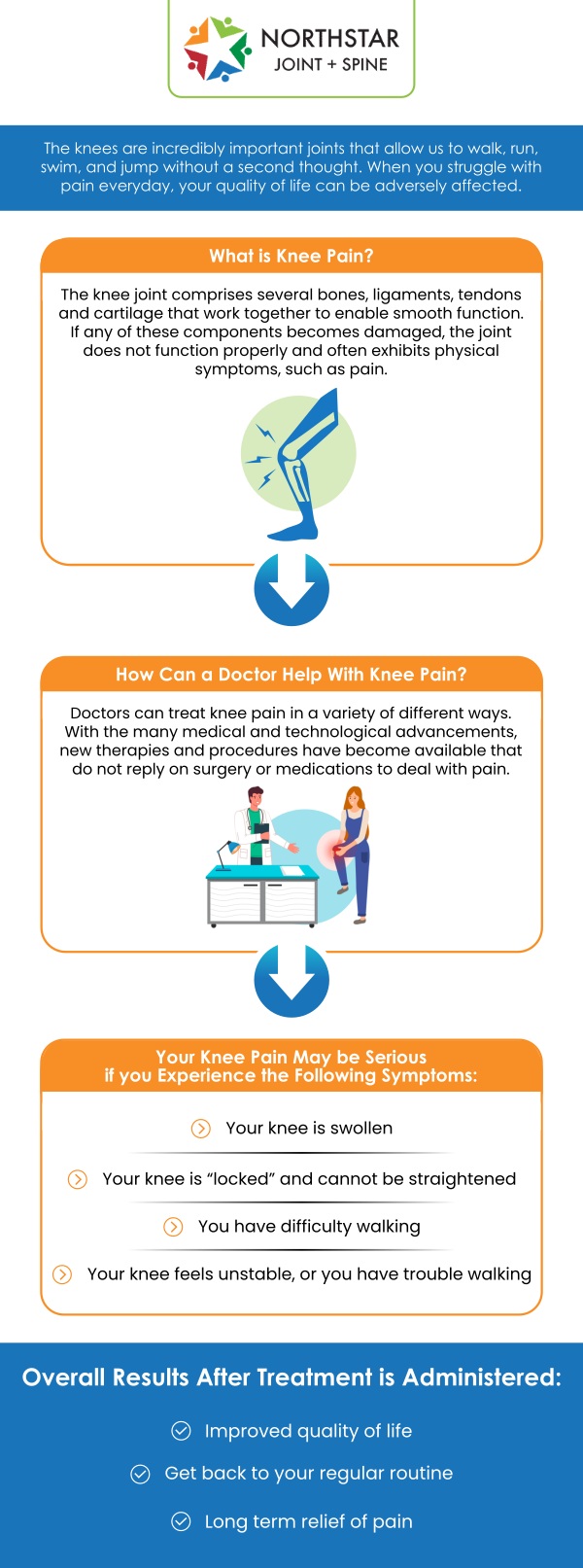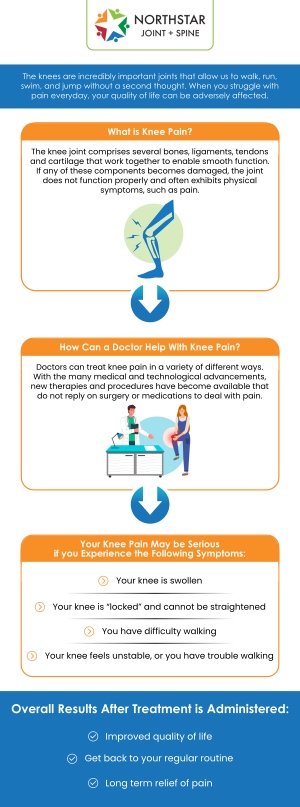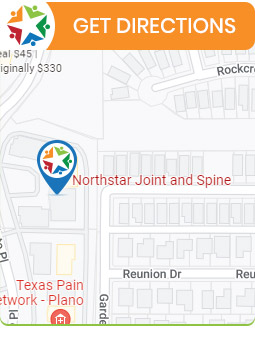Peripheral Nerve Stimulation (PNS) for Knee Pain After Knee Replacement in Plano, TX
At Northstar Joint and Spine, Dr. Robert Nocerini, MD, specializes in providing advanced treatments for knee pain, including Peripheral Nerve Stimulation (PNS). If you’re experiencing persistent knee pain after knee replacement surgery, PNS offers a minimally invasive solution that targets the nerves to alleviate discomfort and improve your quality of life. Trust Dr. Nocerini and his team to deliver personalized, cutting-edge care to help you regain mobility and enjoy a pain-free life. For more information, contact us today or schedule an appointment online now! We are conveniently located at 7704 San Jacinto Pl Suite #200 Plano, TX 75024.




Table of Contents:
What is peripheral nerve stimulation for knee pain after knee replacement?
Is peripheral nerve stimulation effective for post-knee replacement pain?
What are the benefits of peripheral nerve stimulation for knee pain after knee replacement?
How long does it take to see results from peripheral nerve stimulation for knee pain?
Who is a candidate for peripheral nerve stimulation after knee replacement?
Knee Pain Relief After Replacement with Peripheral Nerve Stimulation by Dr. Robert Nocerini in Plano, TX
Peripheral nerve stimulation (PNS) is a procedure that involves implanting a small device under the patient’s skin near the knee, close to a specific nerve-supplying sensation. The device is connected to thin leads and generates adjustable electrical pulses, effectively blocking pain signals from reaching the spinal cord and brain, thus reducing the perceived intensity and frequency of knee pain.
At NorthStar Joint and Spine, we recommend peripheral nerve stimulation (PNS) primarily for patients whose severe knee pain has not responded adequately to other treatments like medication or physical therapy. It’s particularly effective for pain caused by nerve damage or conditions such as osteoarthritis, rheumatoid arthritis, or complex regional pain syndrome (CRPS).
Dr. Nocerini performs the peripheral nerve stimulation (PNS) procedure by making a small incision near the knee, passing a lead wire under the skin, and connecting it to the implanted device. After the procedure, patients typically begin a recovery period of several weeks during which they should avoid strenuous activity and follow Dr. Nocerini’s instructions regarding wound care and device adjustments.
PNS offered at our clinic brings multiple benefits to patients, including a significant reduction in pain intensity and frequency, improved mobility and function, decreased medication use, and enhanced quality of life. It directly targets the source of pain, making it an effective solution for long-term pain management.
While peripheral nerve stimulation (PNS) comes with numerous benefits, it’s important to understand that it also carries potential risks. Dr. Nocerini ensures that patients are fully informed about potential risks such as infection, device malfunction, and nerve damage before undergoing the procedure. While peripheral nerve stimulation (PNS) is not a cure for knee pain, it is a long-term pain management solution that may require regular device adjustments to maintain optimal pain relief.
One of the key advantages of peripheral nerve stimulation (PNS) is its minimally invasive nature and fewer side effects compared to other pain management techniques, such as opioid medications. It’s a flexible treatment that can be adjusted or stopped if it’s not effective or if side effects occur. Peripheral nerve stimulation (PNS) can also be used in conjunction with other pain management techniques, such as physical therapy and medication, for optimal pain relief.
At North Star Joint and Spine, we work closely with patients to determine if peripheral nerve stimulation (PNS) is the best choice for managing their post-knee replacement pain. It’s crucial to understand that while peripheral nerve stimulation (PNS) has shown promising benefits in some studies, more research is needed to identify the specific patient populations most likely to respond to this therapy.
One of the key advantages of PNS is its long-term relief. Unlike temporary solutions like medication, the effects of nerve stimulation can last for months, or even years. This significant improvement in chronic pain management can greatly enhance the quality of life for our patients following knee replacement surgery.
PNS is a non-pharmacological intervention that carries none of the side effects associated with medications, such as dependence or tolerance. This is an important benefit for our patients who may be unable to take certain medications due to other health conditions, or who prefer a non-pharmacological approach.
PNS has also been shown to effectively reduce pain intensity and improve physical function. By reducing knee pain, it enables our patients to participate more comfortably and effectively in physical therapy and other activities. This can facilitate their recovery process and help regain mobility more quickly post-surgery.
By addressing pain and inflammation, peripheral nerve stimulation (PNS) allows patients to move their knee more comfortably, aiding in rehabilitation and daily activities. It can also significantly reduce the need for pain medications, such as opioids. This is particularly beneficial for patients concerned about the side effects or risks of prolonged medication use.
Patients can typically expect to notice some relief within a few days to a few weeks after starting peripheral nerve stimulation (PNS) treatment. The initial signs of improvement are usually a reduction in pain intensity and increased mobility in the affected area. However, the full benefits of PNS may not be apparent until several weeks or even months into the therapy, depending on the individual patient’s condition.
The effectiveness of peripheral nerve stimulation (PNS) and the time it takes to see results can be influenced by a variety of factors, including the severity of the pain, the underlying cause of the pain, and the individual patient’s response to treatment. In some cases, those with more severe pain may take longer to experience relief.
At NorthStar Joint and Spine, we ensure regular follow-up appointments to monitor your progress and adjust the treatment plan as necessary throughout your peripheral nerve stimulation (PNS) treatment. We also encourage our patients to continue with any prescribed physical therapy or exercises, as maintaining physical activity can enhance the effectiveness of the PNS treatment.
This method can be particularly beneficial for those who are not candidates for revision surgery due to risk factors or specific medical conditions. Patients with a functional knee, meaning the joint remains stable and allows daily activities such as walking, climbing stairs, and performing household tasks, may also be suitable candidates for peripheral nerve stimulation (PNS). However, it is crucial for these individuals to be cognitively intact, capable of understanding and following the instructions associated with peripheral nerve stimulation (PNS).
At our practice, we understand that pain management is not a one-size-fits-all solution. Some individuals may have a high tolerance or resistance to pain medications. These patients, who are motivated and willing to commit to the necessary therapy schedule and lifestyle modifications, may benefit significantly from PNS.
Likewise, if you have not found relief from traditional pain management techniques or wish to avoid long-term use of pain medications, PNS could be an alternative. This includes patients who have experienced unpleasant side effects from these medications, those with a history of substance abuse, or individuals who prefer a more natural approach to pain management.
It’s important to have realistic expectations. PNS is a pain management tool rather than a cure and may not completely eliminate all pain. As with any medical procedure, PNS carries its own risks and potential complications. Therefore, a thorough discussion with Dr. Nocerini about the potential benefits and drawbacks is necessary before deciding to proceed with this treatment.
At Northstar Joint and Spine, Board-certified Dr. Robert Nocerini offers specialized Peripheral Nerve Stimulation (PNS) for patients struggling with knee pain following knee replacement surgery. This treatment gently targets the nerves around the knee to decrease pain signals and enhance comfort, supporting faster recovery and improved mobility. The procedure is performed with precision to ensure safety, comfort, and long-lasting relief for Plano residents.
Dr. Nocerini’s expertise in interventional pain medicine allows him to provide a comprehensive and individualized approach to knee pain management. His focus is on helping patients regain stability and independence through innovative, evidence-based therapies. With PNS, many of his patients experience significant improvement in walking and activity levels, making Northstar Joint and Spine a trusted destination for post-surgical knee pain care in Plano, TX.
Our goal is to help our patients lead a life with as little discomfort as possible. We are dedicated to providing personalized care tailored to each patient’s unique needs and circumstances. If you’re considering PNS or any other pain management solution, reach out to us to schedule a consultation. We are conveniently located at 7704 San Jacinto Pl Suite #200 Plano, TX 75024. We serve patients from Plano TX, Willow Bend TX, Frisco TX, Allen TX, Addison TX, North Dallas TX, and surrounding areas.

Check Out Our 5 Star Reviews


Additional Services You May Need
▸ Back Pain
▸ Chronic Pain
▸ Epidural Steroid Injections
▸ Spinal Cord Stimulation
▸ Viscosupplementation
▸ Genicular Nerve Blocks
▸ Facet Injections
▸ Joint Injections
▸ Sacroiliac Joint Injections
▸ Lumbar and Cervical
▸ Facet Medial Branch Blocks
▸ Diagnostic Nerve Blocks
▸ Medication Management
▸ Neck Pain Doctor
▸ Diabetic Peripheral Neuropathy
▸ Headaches
▸ Suboxone
▸ Botox for Migraines
▸ Peripheral Nerve Stimulation
▸ Spine
▸ Joints
▸ Muscles
▸ Bones

Additional Services You May Need
▸ Back Pain
▸ Chronic Pain
▸ Epidural Steroid Injections
▸ Spinal Cord Stimulation
▸ Viscosupplementation
▸ Genicular Nerve Blocks
▸ Facet Injections
▸ Joint Injections
▸ Sacroiliac Joint Injections
▸ Lumbar and Cervical
▸ Facet Medial Branch Blocks
▸ Diagnostic Nerve Blocks
▸ Medication Management
▸ Neck Pain Doctor
▸ Diabetic Peripheral Neuropathy
▸ Headaches
▸ Suboxone
▸ Botox for Migraines
▸ Peripheral Nerve Stimulation
▸ Spine
▸ Joints
▸ Muscles
▸ Bones






